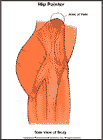
Hip Pointer
What is a hip pointer?
A hip pointer is a deep bruise on the top portion of your pelvis, called the iliac crest.
How does it occur?
A hip pointer is caused by a direct blow to the iliac crest. This injury most commonly occurs in a contact sport such as football, when a helmet is driven into the iliac crest.
What are the symptoms?
You have tenderness in the top portion of your hip.
How is it diagnosed?
Your health care provider will examine your hip and pelvis. He or she may get an x-ray if he or she thinks there might be a fracture to that part of the iliac bone.
How is it treated?
At first, treat your injury with ice packs for 20 to 30 minutes every 3 to 4 hours for 2 to 3 days or until the pain goes away. A hip pointer needs time to heal itself. Protect yourself from further injury by placing padding over the injury.
When can I return to my sport or activity?
The goal of rehabilitation is to return you to your sport or activity as soon as is safely possible. If you return too soon you may worsen your injury, which could lead to permanent damage. Everyone recovers from injury at a different rate. Return to your sport or activity will be determined by how soon your hip recovers, not by how many days or weeks it has been since your injury occurred. In general, the longer you have symptoms before you start treatment, the longer it will take to get better.
You may return to your sport or activity after a hip pointer when you have no pain when walking or running. You will usually have pain with contact to the hip pointer for several weeks after the injury. If a pad taped over the hip pointer provides enough protection during contact, you may continue participating in your sport or activity.
How can I prevent a hip pointer?
A hip pointer is usually not preventable. However, if you are playing a contact sport it is important to wear proper protective padding over this area of your body.

